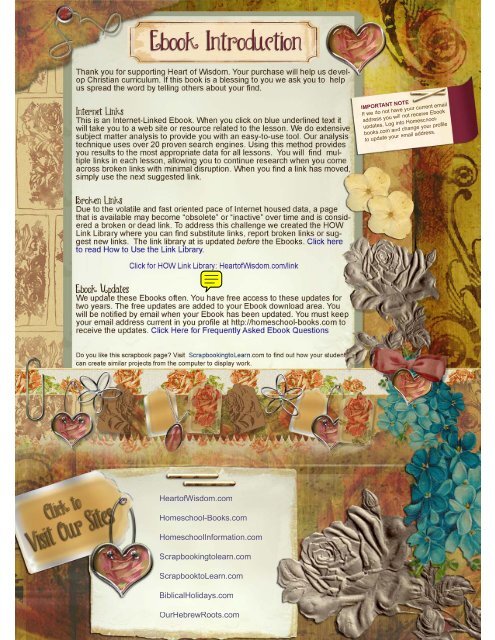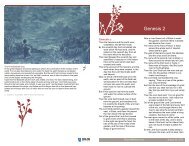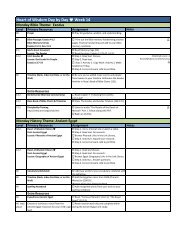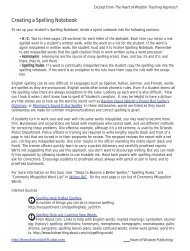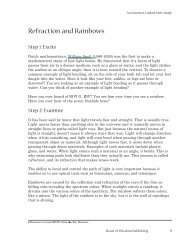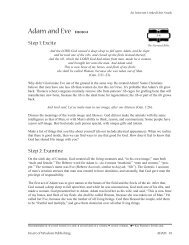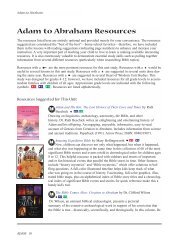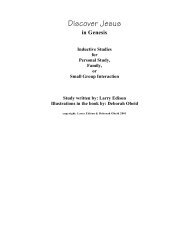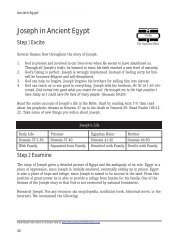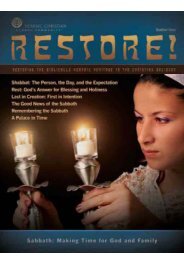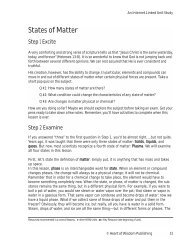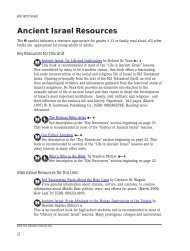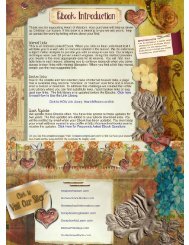Book Excerpt ( 42 pages!) - Heart of Wisdom
Book Excerpt ( 42 pages!) - Heart of Wisdom
Book Excerpt ( 42 pages!) - Heart of Wisdom
You also want an ePaper? Increase the reach of your titles
YUMPU automatically turns print PDFs into web optimized ePapers that Google loves.
SEVENANCIENT HISTORYUNIT STUDIES❖❖❖❖❖❖❖Adam to AbrahamMesopotamiaAncient EgyptAncient IsraelAncient GreeceAncient RomeMessiah UnitBY ROBIN SCARLATA SAMPSON
Part I: How to Use This <strong>Book</strong>How to UseThis <strong>Book</strong>IntroductionIntroduction . . . . . . . . . . . . . . . . . . .1Interacting With Our Web Site . . . . .3The Teaching ApproachHOW Teaching Approach . . . . . . . . .4Bible First Philosophy . . . . . . . . . . .5Delight-Directed Studies . . . . . . . . .7Charlotte Mason Philosophy . . . . . .9The 4 Step Lessons . . . . . . . . . . . .10Writing to Learn . . . . . . . . . . . . . . .14Correcting Written Work . . . . . . . .15ResourcesAbout the Resources . . . . . . . . . . .27Required Resources . . . . . . . . . . . .29Choosing Resources? . . . . . . . . . . .30Key Resource List . . . . . . . . . . . . .31Key Resources in Several Units . . .32Alternative Resources . . . . . . . . . .37Timeline . . . . . . . . . . . . . . . . . . . .39Getting StartedScheduling . . . . . . . . . . . . . . . . . . .16Creating a Portfolio . . . . . . . . . . . .18Creating a Time Line <strong>Book</strong> . . . . . . .19Creating a Vocabulary Notebook . .22Creating a Spelling Notebook . . . . .23Graphic Organizers . . . . . . . . . . . . .26<strong>Heart</strong> <strong>of</strong> <strong>Wisdom</strong> Publishingv
Ancient History: Adam to MessiahStudent Portfolio or Scrapbook PagesJACOBSee more student <strong>pages</strong> in the Gallery on our web site at ScrapbookingtoLearn.comvihttp://Homeschool-<strong>Book</strong>s.com
Part I: How to Use This <strong>Book</strong>IntroductionThe first goal <strong>of</strong> this book is to inspire students to become “hearers and doers” <strong>of</strong> God'sWord and to encourage them to search the Scriptures and apply them to everyday situations.The second goal is to teach students a love <strong>of</strong> learning that will last a lifetime.This book covers a time frame from Creation through the time <strong>of</strong> Christ in two unique ways:1. This book’s focus is on Bible history, as opposed to most ancient-historystudies (even many Christian-based texts), which concentrate on the pagansin ancient times, ignoring God's people. For example, in this book's AncientEgypt Unit the focus is on Joseph, Moses, the Exodus, and God's people(rather than on the pyramids and gods <strong>of</strong> Egypt). Our Ancient Greece andRome units focus on the Israelites fighting against idolatry under Greekand Roman rule (rather than on Greek mythology and Roman gods). Wealso include an in-depth unit study <strong>of</strong> Ancient Israel.2. This book is much more than a basic history study: It is a thematic unitstudy. You will lead your student(s) chronologically on a fascinating journeythrough the Bible as they learn to study, write, research, and reasonthrough many subjects including: Bible History, Geography, Literature,Government, Composition, Agriculture, Religion, Science, Economics, andmore. As your students study, they will have a number <strong>of</strong> valuable experiences.They will write essays, summaries, and editorials. They will have theopportunity to publish their work online. They will dramatize and teach others.These activities will develop their ability to think, which is an assetthat will benefit them throughout their lives.Bible FocusIt is crucial that students understand the ancient times if they are to have a good grasp <strong>of</strong>the Bible. God teaches us through stories about His people. This book is your introduction tothe Mesopotamian world <strong>of</strong> the patriarchs, the Egyptian world <strong>of</strong> the Exodus, the Babylonianworld <strong>of</strong> Daniel, the Persian world <strong>of</strong> Esther, and other Bible stories that show us not onlythe faithfulness <strong>of</strong> our God, and the greatness <strong>of</strong> our privileges, but also the marvelous wisdom<strong>of</strong> the plan <strong>of</strong> salvation.Seventy-eight percent <strong>of</strong> the entire Bible writings (not counting the OT references in the NT),focus on Israel! In this book, you will examine the interaction between the Israelites and theCanaanite, Mesopotamian, Egyptian, Greek, and Roman cultures, which will open your eyesto new-found truths.<strong>Heart</strong> <strong>of</strong> <strong>Wisdom</strong> Publishing 1
Part I: How to Use This <strong>Book</strong>Interacting With Our Web SiteThis book is available in a hyper-linked electronic form (Ebook). Ebook users are assigned aspecial download area at http://Homeschool-<strong>Book</strong>s.com where you can access and downloadseven individual Ebooks (one for each unit). Each Ebook includes hundreds <strong>of</strong> Internet linksto help your student(s) study the lessons. With Ebooks you have the ability search throughthe unit for keywords or to print out <strong>pages</strong> (by unit or lesson or in its entirety) for each member<strong>of</strong> your family. Ebooks include access to downloading any revisions or updates <strong>of</strong> thisbook for two years.IEvery time you see this symbol or underlined text in this book, it indicates that thereis an active link in the Ebook which will take you to one <strong>of</strong> the following: anotherpage on our site (containing a worksheet or detailed instructions), an external sitewith relevant information, or a site from which you can purchase resources.The links include: interactive sites; illustrated sites; video clips; audio clips; lessons fromschools and colleges; dozens <strong>of</strong> encyclopedias; information on where to buy each resource;etc. Giving your student the opportunity to do research in a variety <strong>of</strong> ways increases hisinterest! Our site is continually updated, so we <strong>of</strong>fer new resources and alternatives forbooks that go out-<strong>of</strong>-print.The Internet is a large part <strong>of</strong> our future. Students will be using the Internet in almost anypr<strong>of</strong>ession they choose to enter. The Internet is an open door to an enormous, excitinglibrary. The wealth <strong>of</strong> information on the Internet can be overwhelming because a search fora single topic can lead to thousands <strong>of</strong> links; but <strong>Heart</strong> <strong>of</strong> <strong>Wisdom</strong> guides you to the best andmost appropriate Web sites for each lesson. Throughout the lessons in this book, studentsnot only utilize the Internet, they also learn to navigate it successfully, use search enginesand directories, and evaluate Web sites. Because URLs (Internet addresses) change frequently,we do not include them in this book. Instead, we direct you to our site, where you canclick through to the appropriate sites for that lesson.Utilizing the Internet can create engaged, involved, and active learners. But remember, sittingin front <strong>of</strong> a computer reading through Web <strong>pages</strong> is only part <strong>of</strong> learning. Studies showthat seventy-five percent <strong>of</strong> students need more than reading to retain information. <strong>Heart</strong> <strong>of</strong><strong>Wisdom</strong> incorporates the Internet into the Four-Step Process in each lesson. This processmotivates students to learn, and guides them to activities that help them organize the informationthat they have learned and use it for developing communication skills through writingassignments.Don’t Have Internet Access? There is more than enough information and book resources inthis book to study ancient history without access to the Internet.Links to each history and science theme have been updated and expanded onlineat <strong>Heart</strong><strong>of</strong>wisdom.com/link. Visit for access to the latest information.3
THE HEART OF WISDOM TEACHING APPROACHThe H.O.W. approach is a combination <strong>of</strong> the teaching methods listed belowBible FirstA Return toBiblical HebraicEducationLiving <strong>Book</strong>sCharlotte Mason’sPhilosophy4 Step LessonsIntegrated UnitStudyLifestyle <strong>of</strong>LearningThe Bible is the center <strong>of</strong> education, and all subordinate studies should bebrought into the circle <strong>of</strong> light radiating from the Bible. Academics play animportant part, but they are secondary. Students spend a large portion <strong>of</strong> theschool day studying God’s Word, and the other half studying God’s world inthe light <strong>of</strong> His Word. Click for more on this topic.The Bible outlines how we should teach our children. The ancient Hebraic aim<strong>of</strong> education was ethical and religious. Study is a form <strong>of</strong> worship. The method<strong>of</strong> instruction in the home was oral, and learning was accomplished by practice.The ancient Hebrew taught no distinction between sacred and secular areas <strong>of</strong>life. Every detail <strong>of</strong> life, therefore, must be set aside and consecrated to theglory <strong>of</strong> God. The primary purpose <strong>of</strong> education was to train the whole personfor lifelong, obedient service in the knowledge <strong>of</strong> God (Prov.1:7; Eccl.12:13).Students should develop a love <strong>of</strong> learning by reading real books—literature—as opposed to twaddle, or “dumbed-down” literature. This method also incorporatescopy work, narration (the assimilating <strong>of</strong> information), retelling (sorting,sequencing, selecting, connecting, rejecting, and classifying), creating a TimeLine <strong>Book</strong>, and developing a “Nature Diary.” Click for more on this topic.These four steps are a cycle <strong>of</strong> instruction based on the Four Learning Stylesdeveloped by Dr. Bernice McCarthy. This system is an organized method <strong>of</strong>using all <strong>of</strong> the approaches listed on this page.The “unit” or “theme” part <strong>of</strong> the name refers to the idea <strong>of</strong> studying a topic asa whole instead <strong>of</strong> as several “subjects.” A unit study takes a topic and “lives”with it for a period <strong>of</strong> time, integrating science, social studies, language arts,and fine arts as they apply. This method is ideal for multi-level teaching.An approach outlined in <strong>Wisdom</strong>’s Way <strong>of</strong> Learning by Marilyn Howshall.The emphasis is on parents relying on the Holy Spirit’s guidance to provide theneeded resources so that children can develop expertise in their fields <strong>of</strong> interest.Howshall explains how using these simple and natural tools (with theemphasis on the process <strong>of</strong> learning rather than the product <strong>of</strong> learning) willallow your children to begin to develop their own lifestyle <strong>of</strong> learning.Delight-DirectedLearningStudents acquire basic concepts <strong>of</strong> learning (reading, reasoning, writing,researching, etc.) during the process <strong>of</strong> examining the topic they are interestedin. Education ought to be about building learners’ abilities to do useful things.The focus is on the development <strong>of</strong> learning tools not gaining content.Writingto LearnNoteboook orPortfolioMethodStudents think on paper—think to discover connections, describe processes,express emerging understandings, raise questions, and find answers;encouraging higher-level thinking skills. Students learn to Research,Reason, Relate, and Record.Student create a Bible Portfolio, Unit Study Portfolios, and Time Line <strong>Book</strong>s.As the family re-reads through the Bible every year, each student creates anew Bible portfolio. The Unit Study Portfolios reflect the students collecting,reading, writing and projects on specific topics. Each year, the portfolios willreflect changes in the student’s ability, depth, focus, and spiritual growth.2 Learn more by clicking blue text (indicates an active Internet link).
Part I: How to Use This <strong>Book</strong>Delight-Directed StudiesDelight-directed learning places students in charge <strong>of</strong> their own learning, helping them t<strong>of</strong>ind something which they want to accomplish. The delight-directed method uses naturalcuriosity to motivate the student. The student acquires basic concepts <strong>of</strong> learning (reading,reasoning, writing, researching, etc.) during the process <strong>of</strong> examining the topic <strong>of</strong> interest.Less control can lead to more learning.Each lesson in this book provides enough resources and activities to lead your student into agreat deal <strong>of</strong> in-depth study on a topic. We encourage you to touch on each lesson in eachunit, but also to allow students to study in-depth the lessons they find <strong>of</strong> interest. Whenyour student takes the initiative to do this, set aside any restricted schedules (don’t focus ongetting through the book), and allow your student to enjoy the process <strong>of</strong> learning!Students learn when there is delight not through rigid formal structured studies and schedules.Instead <strong>of</strong> looking at state standards seek God and ask Him what He would have youteach your children. Listen to the Holy Spirit. God promises us wisdom if we ask for it. Whenfollowing God’s guidance not only lead you what to teach your unique individual child but youwill learn to walk a surrendered life, by faith.All children love to learn—at least all children love to learn before they go to school. Forcedlearning can destroy the natural love for learning that our children are born with. Childrenlocked into studying something they find boring are no different than adults locked into boring,irrelevant meetings. If adults cannot see the relevance <strong>of</strong> the material covered in a meeting,they will “tune out” or “drop out.” If children do not understand how the subject willhelp to address the concerns <strong>of</strong> their lives, they will tune out. Would you, for example, readthis page if it were titled “Basic Plumbing Concepts”? You might if you had a kitchen-sinkleak or a basement full <strong>of</strong> water. In the same way, students need to have an interest in thetopic they are learning.If we allow students a free choice, they can concentrate on learning what they might need intheir lives. Freedom to choose what not to study implies freedom to learn more about whatone cares about, and freedom to explore new interests.Roger Schank <strong>of</strong> The Institute for the Learning Sciences explains, in Engines for Education,the importance <strong>of</strong> individualized education. “Depending on an individual's situation andgoals, there are many things that might be worth learning. In order to give a very detailedprescription for what knowledge a student should acquire, we must take into account thatnot every child will need or want to do the same things. A curriculum must therefore be individualized.It must be built around an understanding <strong>of</strong> what situations a particular learnermight want to be in, or might have to be in later in life, and what abilities he will require inthose situations. The methods and the curriculum are molded by the questions that appear<strong>Heart</strong> <strong>of</strong> <strong>Wisdom</strong> Publishing 7
Ancient History: Adam to Messiahon the standardized achievement tests administered to every child from the fourth grade on.Success no longer means being able to do. Success comes to mean “academic success,” amatter <strong>of</strong> learning to function within the system, <strong>of</strong> learning the “correct” answer, and <strong>of</strong>doing well at multiple-choice exams. Success also means, sadly, learning not to ask difficultquestions. When we ask how our children are doing in school, we usually mean, “are theymeasuring up to the prevailing standards?” rather than, “are they having a good time andfeeling excited about learning?” We should purpose to be flexible in the way we try to tapinto our children's innate interests. When we are interacting with the student we can evaluatewhether learning has taken place.A teacher's or parent's first job is to spark the desire in children to read something, to motivatethem to care, so that the natural order <strong>of</strong> learning can kick into action. The educator'sjob is to provide the one item which today's educational system leaves out: motivation.(Schank, 1994). When students are given good instructional materials, they can and willteach themselves, and they will eventually learn to locate their own resources (books, Websites, people, materials, classes, etc.).The Delight-Directed Method is BiblicalThe Bible instructs parents to recognize that each child is a unique individual, with a “way”already established that needs to be recognized, acknowledged, and reckoned with by means<strong>of</strong> the truth <strong>of</strong> Scripture.Proverbs 22:6 says Train up a child in the way he should go, Even when he is old he will notdepart from it. This verse shows us that a parent’s training must be based on knowing his orher child. The Hebrew text is written with the personal pronoun attached to the noun “way.”It reads, “his way” and not simply “in the way he should go.” “Way” is the Hebrew derek,“way, road, journey, manner.” Parents need to recognize the way each <strong>of</strong> their children isbent by the way God has designed each <strong>of</strong> them. If parents fail to recognize this, they mayalso fail to help launch their children into God’s plan for their lives.Marlyn Howshall’s Lifestyle <strong>of</strong> Learning approach 1 is based on leaning on the Holy Spirit anddelight directed learning. She explains, “If the goal <strong>of</strong> your instruction is love from a pureheart (which will only come with an emptying <strong>of</strong> self) then you will provide a strong foundation<strong>of</strong> character in your children that will enable them with your help to acquire a strongand unique, God-designed education which will include creative vocational purpose. If youwant godly fruit, you have to know God and do things His way. You won't learn what His wayis until you decide you want to know what it is and surrender your will to become completelyteachable <strong>of</strong> the Holy Spirit.”1. For more about Marylin Howshall’s Life Style <strong>of</strong> Learning approach see: The Lifestyle <strong>of</strong> Learning Approach, <strong>Wisdom</strong>'sWay <strong>of</strong> Learning. Available from Lifestyle <strong>of</strong> Learning, P.O. Box 145, Bedford, VA 24523. Email LOLearning@aol.com.8 http://Homeschool-<strong>Book</strong>s.com
Ancient History: Adam to MessiahThe 4 Step LessonsEach lesson in this book contains four basic steps. These four steps are a cycle <strong>of</strong> instructionbased on the four learning styles identified in The 4Mat System developed by Dr. BerniceMcCarthy. Each <strong>of</strong> the four steps teaches to one <strong>of</strong> these four learning styles. This cycle <strong>of</strong>learning is based on the fact that different individuals perceive and process experiences indifferent, preferred ways; these preferences comprise our unique learning styles. Studentsbecome comfortable with their own best ways <strong>of</strong> learning, and grow through experience withalternative modes. The chart below gives an overview <strong>of</strong> the four learning styles.Type 1Type 2Type 3Type 4A Type One learner is onewho perceives concretelyand processes by thinkingthrough an idea.Type Ones are “people”people. They learn by listeningand sharing ideasand by personalizinginformation. They need tobe personally involvedand seek commitment.They tackle problems byreflecting alone and thenbrainstorming with others.They demonstrateconcern for people. Theyexcel in viewing concretesituations from many perspectivesand modelthemselves on those theyrespect.A Type Two learner is onewho perceives abstractlyand processes activelyworking with an idea.Schools are made forthese types <strong>of</strong> learners.They are eager learnerswho think through ideas.They are thorough andindustrious, and excel intraditional learning environments.They are excellentat discerning detailsand at sequential thinking.They tackle problemsrationally and logically.They are less interestedin people than concepts.A Type Three learner isone who perceivesabstractly and processesby thinking through anidea.Ninety-five percent <strong>of</strong> theengineers tested are Type3. They excel at down-toearthproblem solving.They are common-sensepeople. They have a limitedtolerance for fuzzyideas. They experimentand tinker with things.They tackle problems byacting (<strong>of</strong>ten without consultingothers). Theyneed to explore, manipulate,and experiencethings to understand howthings work.A Type Four learner isone who perceives concretelyand processesactively working with anidea.These types <strong>of</strong> learnersseek to influence others.They learn by trial anderror. They are self-discoverylearners. Theythrive on challenge. Theyadapt to change and relishit. They tend to takerisks and are at ease withpeople. They perceivethings with emotions andprocess by doing. Theyneed to be able to usewhat they have learned.The most important thing to realize about learning styles is that one style is not better thananother. We all have different intellectual strengths. No one fits into a box; we are all uniqueindividuals created by God. Each <strong>of</strong> us is a combination <strong>of</strong> the four types, more or less, in oneor two categories. Studies show that seventy percent <strong>of</strong> children do NOT learn well throughthe way the schools teach—lecture/textbook/test—most students need more. The Bibleteaches that we are all different parts <strong>of</strong> the body <strong>of</strong> Christ and that one part is no betterthan another part (1 Corinthians 12:12-25).10 http://Homeschool-<strong>Book</strong>s.com
Part I: How to Use This <strong>Book</strong>The 4MAT® model consists <strong>of</strong> fourinstructional goals:1. Motivating students2. Teaching ideas and facts3. Experimenting withConcepts & Skills4. Integrating new learninginto real life.ApplicationStep 4EXCELLet them teach itto themselvesand others.MotivationStep 1EXCITECreate a reason.Motivate the studentby making the lessonmeaningful to his/her life.It addresses four styles <strong>of</strong> learners:1. Those who learn by listeningand sharing ideas2. Those who learn by conceptualizing— integratingtheir observations into what isknown,3. Those who learn by experimenting—testingtheories inpractice4. Those who learn by creating—actingand then testingtheir new experiencePractice4Mat SystemStep 3EXPANDLet them try it out.Sometimes called “messingaround.” They should dosomething with whatthey have learned.Step 2EXAMINEGive the facts.Include textfrom a Christianworld view.ConceptDevelopm entStep 4Narration.Tell back what youhave learned;share with others.CharlotteMasonStep 1Motivate thestudent by makingthe lesson interestingon his/her level—not"dumbed down."Charlotte Masonand 4Mat!The <strong>Heart</strong> <strong>of</strong> <strong>Wisdom</strong>approach creates lessonplans using CharlotteMason methods and teachingto the four styles.Step 3Do something with what youhave learned. Copy work,dictation, adding toa nature notebookor time line.Step 2Give the facts fromliving books, nature,and humanities.Its a new creative way toorganize Charlotte Mason’sunique methods.<strong>Heart</strong> <strong>of</strong> <strong>Wisdom</strong> Publishing 11
Ancient History: Adam to MessiahStep 4Israel was to instructall nations in divineholiness and redemptionas Yahweh's instrument<strong>of</strong> light to the nations.Step 1Motivation—Israel's mandate wasto diligently teach theirchildren to love God, andto know and obey his statutesand ordinances (Deut 6:1-9).Modern-day science may have comeup with the 4Mat System, but is itreally a new way to teach or havewe had thispattern all along?Step 3Oral and written recitation.Repetition in observation,experiential learning (doing),listening, reciting,and imitating.Education inBible TimesStep 2The aim <strong>of</strong> education was ethicaland religious, centering onthe Torah and recognizingand remembering events<strong>of</strong> divine providencein history.Ultimately, biblical education isinstruction in a lifestyle. For thisreason, the apostle Paul remindedhis pupil Timothy, you … know allabout my teaching, my way <strong>of</strong> life …continue in what you learned … (2Tim 3:10,14). Not only is biblicaleducation a lifestyle—it is a lifetime!The 4Mat lessons are designed sothat all learning styles areaddressed, in order that more thanone type <strong>of</strong> student may be permittedto both “shine” and “stretch.”Each lesson contains “somethingfor everybody,” so each student notonly finds the mode <strong>of</strong> greatestcomfort for him/her, but is challengedto adapt to other, less comfortablebut equally valuablemodes.Step 4He asked them to goand tell others.“Go ye therefore,and teach all nations...”Step 3He asked them to dosomething with what theylearned—to activelyrespond—doingand practice are vitallyconnected withknowing.How JesusTaughtStep 1He took the peoplewhere they were andmade the lesson meaningfulto their lives in some way.He spoke to shepherds aboutsheep, farmers about planting,fishermen about fish, etc.Step 2He brought in the facts—Scripture, “It is written,...”12 http://Homeschool-<strong>Book</strong>s.com
Part I: How to Use This <strong>Book</strong>Studies show that this four-step method motivates students to comprehend the material betterand retain the information longer. Dozens <strong>of</strong> studies have been done comparing the 4MatSystem to traditional textbooks. These studies show again and again that students learningunder the 4Mat System achieved significantly greater gains than students in the textbookgroup. 1Since the development <strong>of</strong> this teaching approach, Dr. McCarthy has achieved national recognitionas a leader in the instructional field. The 4MAT System is being used by hundreds <strong>of</strong>thousands <strong>of</strong> teachers throughout the country to design and develop unit plans for every agegroup; kindergarten, college, law, medical schools, etc. In documented field studies <strong>of</strong> the4Mat System the following outcomes have been found to recur consistently:Improved Retention ............From the earliest stages <strong>of</strong> implementation, students showsignificantly better recall <strong>of</strong> information when taught withthe 4MAT System.Higher Achievement ...........On objective achievement tests measuring knowledge, comprehension,application, and analysis, 4MAT students scoresignificantly higher than their traditionally taught counterparts.Increased Motivation .........Qualitative studies show that teachers and students displaymore-positive attitudes toward learning with 4MAT thanwith traditional methods. Teachers report more frequent collaboration,greater commitment to assessment, and a deeperappreciation <strong>of</strong> the teacher’s role as a motivator.Improved Thinking Skills ..In studies measuring analytical and creative thinking, 4MATstudents show a substantially better command <strong>of</strong> basicthinking skills than control groups. Improvements tend to bemost dramatic in verbal and figural creative thought.Lower Remediation ............4MAT substantially improves success rates with at-risk andspecial-education students. The need for re-teaching alsodeclines.1. For more on this subject see: The 4MAT System, Teaching to Learning Styles with Right and Brain Processing Techniquesby Bernice McCarthy; 4Mat in Action by Susan Morris and Bernice McCarthy; The 4Mat System Workbook; 4Mation DeveloperS<strong>of</strong>tware by Excel, Inc; 4Mation Lesson Bank by Excel, Inc.<strong>Heart</strong> <strong>of</strong> <strong>Wisdom</strong> Publishing 13
Ancient History: Adam to MessiahWriting to LearnOne <strong>of</strong> the best ways for a student to understand a topic is to write about it. Students mustcomprehend the material, restructure the new information, and then share their new understanding.“Writing to Learn” 1 is much more than an accumulation <strong>of</strong> report writing; it helpsstudents think and learn carefully and completely. Writing assignments are about creatingboth ideas and learning. During writing assignments, students learn how to assess informationand determine its appropriateness, to evaluate and compare, analyze and discern, addtheir own feelings, organize information, and communicate conclusions. Through theseprocesses, students learn to manage and use information to solve problems, interrelateknowledge, and effectively communicate learning outcomes. Students develop excellence inachievement by producing the required quality assignments; they develop diligence by continuallypracticing clarity, accuracy, relevance, prioritizing, consistency, depth, and breadththrough writing activities.Charlotte Mason's narration methods for younger children involve “telling back” favorite storiesread by parents. In later years, students progress to reading passages and “telling back”in verbal or written form what they have learned. Talking it out, whether aloud or on paper,helps students think.Often teachers use writing as a way <strong>of</strong> testing. They use it to find out what students alreadyknow, rather than as a way <strong>of</strong> encouraging them to learn. But the active processes <strong>of</strong> seekinginformation, compiling notes, and evaluating, analyzing, and organizing content, as well asthe processes <strong>of</strong> personal reflection, choosing and constructing words, and expressing ideasin writing, are valuable learning tools which students will use the rest <strong>of</strong> their lives.Catherine Copley explains in The Writer's Complex:Writing provides food for thought—it enables you to knead small, half-baked wordsand sentences into great big loaves <strong>of</strong> satisfying thought that then lead to morethoughts. Developing ideas involves getting some ideas—in whatever form—ontopaper or screen so you can see them, return to them, explore them, question them,share them, clarify them, change them, and grow them. It really is almost likegrowing plants or kneading bread and waiting for the results: plant the seed, startthe process, and then let your mind, including your unconscious, take over. Go tosleep and let your dreaming continue to develop your ideas. Humans were born tothink; it's almost impossible to stop us. Writing helps us to bring all that activityinto consciousness, helps to clarify and direct our thinking, and generate morethinking. Writing, thinking, and learning are part <strong>of</strong> the same process. 21. For more on this subject see the “Writing to Learn” chapter in Writers INC or Writing to Learn by William Zinsser,HarperCollins; ISBN: 0062720406.2. Copley, Catherine. (1995) The Writer's Complex, Empire State College 14 http://Homeschool-<strong>Book</strong>s.com <strong>Heart</strong> <strong>of</strong> <strong>Wisdom</strong> Publishing
Part I: How to Use This <strong>Book</strong>Correcting Written WorkYou and your student will need a writing handbook to use with this book. We recommendWriters Inc: A Student Handbook for Writing and Learning (see description on page 29); you oryour student will be referring to this book in almost every lesson.You will correct spelling, capitalization, punctuation, grammar, sentence structure,subject/verb agreement, consistent verb tense, and word usage in all writing by markingeach error with a number that corresponds with a rule from Writers INC. The student refersto the rule in the book, corrects his paper, and turns it back in.Read through “The Writing Process” in Writers INC with your student. It is important foryour student to understand the stages in the writing process: Prewriting, Drafting, Revising,Editing, and Publishing. Explain to your student that you will accept his or her writing in differentstages. Requiring all work to be “published” can discourage writing. Throughout thelessons your student will be asked to write summaries, paraphrases, letters, essays, etc.Much <strong>of</strong> the time you can accept rough drafts, but occasionally (especially in adding work tothe Portfolio) your student needs to go through the entire process.Through the writing assignments, students will learn:• Writing Skills: Context, form, mechanics, editing, and revision.• Spelling Skills: Create a personal Spelling Dictionary.• Vocabulary Skills: Create a personal Vocabulary Notebook.• Handwriting Skills: Practice writing Bible verses.• Critical Thinking Skills: Manage and use information to solve problems, interrelateknowledge, and effectively communicate learning outcomes.• Character Development through assignment completion: Attentiveness, commitment,confidence, decisiveness, efficiency, faithfulness, perseverance, promptness, responsibility,and self-control.Online Writing TutorsIf you don’t feel qualified to teach or pro<strong>of</strong>read your students' work we can connect you to apr<strong>of</strong>essional online writing tutor available monthly or annually. If you purchase the programyour student works with a mentor to improve upon various writing skills. If your child needshelp with any <strong>Heart</strong> <strong>of</strong> <strong>Wisdom</strong> writing assignment --research papers, book reviews, journalwriting, grammar, poetry-- he or she will be assigned a mentor who can coach them. All contactis via e-mail and the turn around is within 24 hours, so feedback, input, and new lessonsarrive promptly and result in an incredibly high level <strong>of</strong> student interest and enthusiasm. Youcan use a tutor until you feel comfortable teaching your student or use the tutor long term..<strong>Heart</strong> <strong>of</strong> <strong>Wisdom</strong> Publishing 15
Ancient History: Adam to MessiahGetting StartedThe whole foundation <strong>of</strong> the <strong>Heart</strong> <strong>of</strong> <strong>Wisdom</strong> philosophy is to give up man's standards andlean on God for what He would have us teach our children. Matthew 6:33 is our focus, "Seekye first the kingdom <strong>of</strong> God, and his righteousness; and all these things shall be added unto you." Ifwe focus on teaching our children God's Word he will take care <strong>of</strong> any other needs. Havefaith! Pray and seek God’s leading. There is no better way to plan —let Him take youthrough His book at His pace! God's yoke is easy, and His burden is light—let the Spiritdirect your schooling. When we lean on Him, He will transform every area <strong>of</strong> our lives! (Mat11:28–30.)There are several ways that you can use this book. The schedule listed is only a guideline tocomplete this book in a one year (36 week) period. There are enough resources and activitieslisted to spend one year studying a single unit or even several months on some <strong>of</strong> the lessons.Use the schedule below as a very loose guide. Remember the goals:1. To learn and obey God’s Word.2. To develop a love <strong>of</strong> learning, and a lifestyle <strong>of</strong> learning.Unit Lessons One Year Schedule Schedule for Your Family1 Adam to Abraham 16 4 Weeks2 Mesopotamia 13 3 Weeks3 Ancient Egypt 38 6 Weeks4 Ancient Israel 43 7 Weeks5 Ancient Greece 31 5 Weeks6 Ancient Rome 38 7 Weeks7 Messiah 27 4 WeeksFollow your student’s delight and allow them study topics <strong>of</strong> interest in depth. Adjust thisschedule to fit the needs <strong>of</strong> your family as the Lord leads. A typical school year is 180 daysor 36 weeks. There are 206 lessons in this book. Using the one year schedule, studentsshould complete 5 to 6 lessons a week. Some homeschoolers are finding two years in thisbook gives a good foundation <strong>of</strong> Bible times.You decide the pace. Understand you can certainly complete more than one lesson a day. Forexample the Ancient Greece Lessons about funerals, weddings, drama and education can becompleted in few hours in one day. More important lessons like understanding God’scovenant with Abraham might take two days study time. Be anxious for nothing, but in everythingby prayer and supplication, with thanksgiving, let your requests be made known to God;and16 http://Homeschool-<strong>Book</strong>s.com
Ancient History: Adam to MessiahCreating a PortfolioA Portfolio is simply a three-ring notebook that is used to store the student’s work for each unit,including writing assignments, artwork, small collections, letters, photos, brochures, maps, etc.To set up your Portfolio you will need: a three-ring notebook with a clear-plastic pocket cover, avariety <strong>of</strong> paper, cardstock, top-loading sheet protectors (for photos, brochures, maps, etc.), anda three-hole punch.Scrapbooking to LearnCombine scrapbooking techniques with Charlotte Mason's copy methods for a great displayor addition to your unit study portfolio. Some students thrive on creativity; for them, we suggestscrapbook supplies (memory albums, stickers, die cuts, paper, cardstock, scissors, pens,punches, templates, rulers, idea books, etc.). Students can decorate papers with illustrations,stickers, frames, etc. There are thousands <strong>of</strong> scrapbook ideas on the Internet; you can find themby simply typing “scrapbook” into any Search Engine. Scrapbooking is incredibly rewarding,Students show enthusiasm about almost any subject if there are able to scrapbook. See thelast page <strong>of</strong> this book for more on “scrapbooking to learn” and patterns for paper people. Seeour gallery for students samples or and ScrapbooktoLearn.com for downloadable clipart.CoverStudents can create a cover by drawing on paper with markers or crayons, making a collage,using pictures from the Internet, or enlarging a color photo at a local copy center. Studentscan then slide the finished product into the pocket covering their notebook. If your studentexperiences a block in creating a cover design, leave the cover blank until he or she feelsinspired.DivisionStudents can use index dividers or colored paper dividers, and make a title page for eachunit: Adam to Abraham; Ancient Mesopotamia; Ancient Egypt; Ancient Israel; AncientGreece; Ancient Rome; and The Messiah. If you prefer, you can make an entire notebook foreach time period.ContentsYour students will include essays, reports, stories, poems, songs, Bible verses, journalentries, book reviews, dictation lessons, photographs <strong>of</strong> projects, computer-produced graphics,memorabilia, recipes, maps, Internet printouts, illustrations, etc. Your students shoulddemonstrate correct grammar, punctuation, spelling, and vocabulary usage in all writing, andcomplete all corrections, rewrites, and improvements. They can store oversized artwork easilyby folding poster board in half, stapling the sides perpendicular to the fold (which has nowbecome the bottom), and slipping artwork in the top.18 http://Homeschool-<strong>Book</strong>s.com
Part I: How to Use This <strong>Book</strong>Creating a Time Line <strong>Book</strong>In her writings, Charlotte Mason recommended preparing a handmade Time Line <strong>Book</strong> (originallycalled a Museum Sketch <strong>Book</strong>; sometimes called a <strong>Book</strong> <strong>of</strong> the Centuries). This activityis based upon one <strong>of</strong> the major keys to motivation: the active involvement <strong>of</strong> students in theirown learning. Students learn by doing, making, writing, designing, creating, and solving.Creating this Time Line <strong>Book</strong> is a marvelous way for students to not only be actively involvedbut to “pull it all together” and grasp the flow <strong>of</strong> biblical and historical events.In a short period <strong>of</strong> time, students can complete an illustrated time line page that tells astory, resulting in immediate feedback that is satisfying and rewarding. Then, as your studentslearn historical facts, they will make notes and sketches in their book, on the appropriatedated page, about famous people, important events, inventions, wars, etc. (Work thatincludes undated information about a time period, such as daily life, education, etc., fits betterinto the Portfolio, but you can combine the two books if you wish.)To get started, you can purchase a blank <strong>Book</strong> <strong>of</strong> the Centuries published by Small VenturesPress, or make your own with the instructions below.To Set Up Your Time Line <strong>Book</strong>You will need: a three-ring notebookwith a clear-plastic pocket cover, blank8.5” x 11” <strong>pages</strong>, smaller lined <strong>pages</strong>(8.5” x 11” cut down to 8.5” x 9”), and athree-hole punch. An option is to choosea color for the <strong>pages</strong> <strong>of</strong> each unit (peachfor Mesopotamia, pink for Rome, bluefor Israel, etc.).DatesImage areaDatesDecide upon the units <strong>of</strong> time you willuse (decades, centuries, etc.) to divideyour time line into segments. A timeline documenting the period from Adamto the Messiah will begin with Creation(before 2000 B.C.) and end with the resurrection<strong>of</strong> Christ (c. A.D. 30). (Thenice thing about the notebook styletimeline is that it's cumulative; everyyear's study can be added in. You cancontinue this time line as you studylater periods by adding <strong>pages</strong>.) As youstudy each period, there will be timesNotes, outlines, etc. (typed orhandwritten).The notes can be pasted on the samepage as the images or added as a shortersheet <strong>of</strong> lined paper.<strong>Heart</strong> <strong>of</strong> <strong>Wisdom</strong> Publishing 19
when you will document decades on one page, and other times when you will document severalcenturies on one page. Place the appropriate section <strong>of</strong> the time line across the top <strong>of</strong>each 8.5” x 11” page to represent increments. The shorter lined <strong>pages</strong> will go in betweenthese <strong>pages</strong> to hold notes. If there is not room on your time line to include all <strong>of</strong> yourchronology, cull some <strong>of</strong> the dates or add <strong>pages</strong> with larger segments that leave more room.Use the time lines in this book as a guide.Time Line IllustrationsThere are many ways to illustrate the <strong>pages</strong>.1. Students can draw, trace, or sketch illustrations.2. Print out clip art from the Internet. Thousands <strong>of</strong> illustrations, maps, Christian clipart, etc., are available on the Internet. A few examples are shown on the sample <strong>pages</strong>.3. Photo copy illustrations from book such as below or use premade illustrationsfrom a packet. See Timeline History through the Ages: Creation to Christ Packet. .A Note About Bible DatesDon’t be surprised to find several hundred years difference in B.C. time lines (such as thoseon the Internet, in Holman Bible Atlas, or in Reproducible Maps, Charts, Time Lines andIllustrations). Scholars disagree about Bible dates, especially before Abraham (c. 2100 B.C.).The time lines in this book are based on conventional chronologies. The most importantthing is that students see the chronological progression. Explain to your student(s) that the“c.” stands for circa which means “approximately.”Click here to view several Timeline Resources.Click here to view student <strong>pages</strong> in the Gallery at ScrapbookingtoLearn.com20 http://HomeSchoolUnitStudies.com
c. 1453 B.C. c. 1453B.C.300 130 B.C.264-241 BC First Punic WarMoses, Passover, the ExodusWanderings Begin218-202 BC Second Punic WarThe Third Punic War: 149-146 BC1500 B.C. 1450 B.C.1743 Hatshepsut Crowned1455 Hatshepsut dethronedMosesExod 2:1-10 - BirthExod 3:1-22 - CallExod 14:15-31 - ExodusExod 34:27-35 - Receives the LawDeut 34:1-12 - DeathMoses' story begins with his preservation as a child in the reedsby the river Nile. Moses was brought up in Pharaoh's court inHatshepsut's LifeEgypt. As an adult Moses was angered by the oppression <strong>of</strong> theHebrew people. Seeing an Egyptian task master beating aHatshepsut was considered one <strong>of</strong> the greatestHebrew, Moses killed the Egyptian and fled to Midian. Whilerulers, male or female <strong>of</strong> her time. Born duringMoses was a shepherd in Midian, God spoke from a burning bushEgypt’s 18th dynasty, she was able to rise fromand called him. His task was to go back to Egypt to bring aboutprincess to queen to pharaoh. Her rise to the throne,the deliverance <strong>of</strong> God's people, Israel. God also disclosed thatthough against ideals <strong>of</strong> the time, might havethe divine name was "I Am." When Moses hesitated, God told himinspired others, such as Cleopatra. During this timethat his brother Aaron could be his spokesman. The plagues, theshe was able to expand trade, watch the Egyptiancrossing <strong>of</strong> the Red Sea, the gifts <strong>of</strong> manna, quails, and water inthe desert were signs that God was leading his people. Moseseconomy grow and improve, and build and restorebrought the law from Mt. Sinai. Moses was unique in that hetemples <strong>of</strong> Egypt. Hatshepsut did this by claimingspoke with God "face to face." While in the wilderness, Mosesright <strong>of</strong> male, being in the image <strong>of</strong> the Sphinx. Shefailed to honor God for providing water from a rock. Because <strong>of</strong>strapped a golden beard to her chin and <strong>of</strong>tenthis God did not allow Moses to enter the promised land, but onlydressed in male clothing .1 to look at it from Mount Nebo in the land <strong>of</strong> Moab. He died inTransjordan. (From BibleTutor.com)<strong>Heart</strong> <strong>of</strong> <strong>Wisdom</strong> Publishing 21
Ancient History: Adam to MessiahCreating a Vocabulary NotebookTo set up your student's Vocabulary Notebook, divide a spiral notebook into 26 sections (onefor each letter <strong>of</strong> the alphabet), allowing two or three <strong>pages</strong> per letter. Read “ImprovingVocabulary Skills” in Writers INC.It's best to keep vocabulary separate from the Unit Portfolios, because many <strong>of</strong> the newwords your student will learn along the way will not be specific to the thematic unit.Vocabulary Notebook <strong>pages</strong> can be helpful for students not only to observe their progress,but also to establish an increasing awareness in reading. Research has shown that it is mucheasier to remember words in context than in simple lists. Computer option: students can alsokeep their vocabulary words in a file on the computer.Each day, students should make a vocabulary list <strong>of</strong> unknown words found while reading. Atthe end <strong>of</strong> the reading, students will be expected to make vocabulary entries into their notebooks.If the student does not come across any new words, choose new words from the“Vocabulary” section <strong>of</strong> the current unit study. The student should arrange the entries as follows:1. Write the date <strong>of</strong> the entry next to the word.2. Include the sentence where you first found the word.3. Write the definition <strong>of</strong> the word from context.4. Write the antonym <strong>of</strong> the word as derived from context.5. Write one complete sentence using the word.Exampleintact – (7/9/00) “The deck was torn and scattered, but the precious engine was intact.”“The Lawgiver” p. 239.Definition: unharmed, untouched.Antonym: destroyed, torn apart.Sentence: I was pleased to find my house intact after the tornado warnings had passed.Root WordsStudents should study word roots. Many English words have Latin roots. When a studentlearns one root, he/she can <strong>of</strong>ten learn many new words. For example, the Latin root “tele”means “to distance,” and this root is found in many English words, such as the following:telephone, telescope, etc.ReviewOnce a week, verbally go over a random list <strong>of</strong> words. Ask the student to use each word in asentence. Check <strong>of</strong>f the words that the student masters. Review all words at the end <strong>of</strong> thesemester.22 http://Homeschool-<strong>Book</strong>s.com
Part I: How to Use This <strong>Book</strong>Creating a Spelling NotebookTo set up your student's Spelling Notebook, divide a spiral notebook into 26 sections (one foreach letter <strong>of</strong> the alphabet). Add any words that the student has trouble spelling. Read“Steps to Become a Better Speller,” “Spelling Rules,” and “Commonly Misspelled Word List”in Writers INC.Each time you notice a misspelled word in a student's written work, write the word on a listfor the student. (Remember to add misspelled words that the spell-checker finds in workwritten using a word processor.) If the word is again misspelled in written work, the studentmust add it to his/her Spelling Notebook.Overcoming Continually Misspelled WordsIf students turn in work over and over with the same words misspelled, you may need tobecome more firm. Businesses and corporations are faced with employees who cannot spell,and use different methods for correcting these problems. One effective example, although it’sa bit extreme, is used by the Orlando Police Department. Police <strong>of</strong>ficers in training arerequired to write lengthy reports (back and front <strong>of</strong> a page in ink) that are turned in to theirsergeants for review. The sergeant reviews the report with a red pen, circling any misspelledwords. One error results in the <strong>of</strong>ficer rewriting the entire report (back and front). Thetrainee <strong>of</strong>ficers quickly learn to carry a pocket dictionary and carefully pro<strong>of</strong>read reports.We're not suggesting that you use this approach; you don't want to discourage writing. Butyou can modify this approach by allowing students to use erasable ink. Hand back paperswith spelling mistakes and ask for corrections. Encourage students to pro<strong>of</strong>read aloud,always with pencil or pen in hand, and to pro<strong>of</strong>read backwards.Hebrew and Greek NotebookSeveral <strong>of</strong> the lessons in this book include references to Hebrew or Greek words. Encouragestudents to look up the Hebrew or Greek word in a Lexicon. (See our web site for activelinks to Crosswalk’s New Testament Greek lexicon based on Thayer's and Smith's BibleDictionary and Crosswalk’s Old Testament Hebrew lexicon based on Brown, Driver, Briggs,Gesenius Lexicon.) Your student should have an assigned place to keep these words and thedefinitions in a notebook, or in a section <strong>of</strong> his/her Portfolio.<strong>Heart</strong> <strong>of</strong> <strong>Wisdom</strong> Publishing 23
Ancient History: Adam to MessiahGraphic OrganizersThroughout the lessons you will see several organization activities. These are convenientways <strong>of</strong> organizing notes and thoughts about a topic. Graphic Organizers can be powerfulteaching tools; students remember text better if it is turned into a graphic. The next few<strong>pages</strong> show examples <strong>of</strong> different types <strong>of</strong> Graphic Organizers.Mind MappingA Mind Map (or Concept Map) is a convenient way <strong>of</strong> organizing notes and thoughts about atopic. Your students can use it in brainstorming and planning, to help them grasp and expandlearned concepts. Mind mapping is a nonlinear activity which generates ideas, images andfeelings around a stimulus word. As students “cluster,” their thoughts tumble out, enlargingtheir word bank for writing and <strong>of</strong>ten enabling them to uncover patterns in their ideas.GroupedConciseFastNewInformationThinkingSkillsLearningStyleBalancedWholeBrainInformationTakingNotes<strong>Book</strong>sVideosLectureManyGenerateIdeasMindMappingComputerNeaterColorsCreativityMaterialsFasterExpressDoodlesImagesMarkersLargePaperSymbolsRetain24 http://Homeschool-<strong>Book</strong>s.com
Part I: How to Use This <strong>Book</strong>Mind maps on this page are by eMindMaps: Trial free mind-mapping s<strong>of</strong>tware. See http://www.mindjet.com.Click here for more mindmaps<strong>Heart</strong> <strong>of</strong> <strong>Wisdom</strong> Publishing 25
Ancient History: Adam to MessiahContrast-and-Compare GraphicsItem 1 Item 2A comparison is a systematic strategy for Attribute 1analyzing and evaluating the similarities <strong>of</strong> Attribute 2two or more things. (A contrast is simply acomparison that emphasizes differences Attribute 3rather than similarities.) An effective comparisonattempts to demonstrate one <strong>of</strong> three general purposes: Two things thought to be differentare actually similar; two things thought to be similar are really quite different; twothings, although comparable, are not equal—one is better than the other.Venn DiagramThe Venn Diagram is made up <strong>of</strong> twoor more overlapping circles. It is<strong>of</strong>ten used in mathematics to showrelationships between sets. In languagearts instruction, the Venn CharacteristicsDiagram is useful for examining similaritiesand differences between char-<strong>of</strong> item 1 onlyin this spaceacters, stories, poems, etc. It is frequentlyused as a prewriting activityto enable students to organizethoughts or textual quotations priorto writing a compare/contrast essay.This activity enables students toorganize similarities and differences visually.Item 1Characteristics<strong>of</strong> both itemsin this spaceItem 2Characteristics<strong>of</strong> item 2 onlyin this spaceStoryboardsA storyboard (or flowchart) is a graphic, sequential depiction<strong>of</strong> a narrative. A time line is a form <strong>of</strong> storyboarding.It helps students to think visually about the sequence <strong>of</strong>scenes. It develops defining and analyzing processes whilebuilding a step-by-step picture <strong>of</strong> the process for analysis,discussion, or communication purposes. A storyboard canbe a simple cartoon strip with illustrations, or boxes withtext that tell a story.ApproachCounterOrder BurgerWant Fries?NOPayCashierYESStandardProcess forOrdering aBurgerOrder FriesBeginning Middle EndClick here for Graphic OrganizersUnderlined text refers to Internet link.26
Part I: How to Use this <strong>Book</strong>About the Recommended ResourcesFour Types <strong>of</strong> Resources Recommended1. Bible Study Tools2. Reference <strong>Book</strong>s: Students read specific portions <strong>of</strong> the reference books for each lesson.3. Literature and Classics (novels and stories): to be read during the course <strong>of</strong> the unit.4. Internet SourcesBible Study ToolsYou should have several Bible study tools on hand: a KJV Bible; The Narrated Bible (explainedin the Required Resources Section), a Bible Atlas (we recommend The Holman Bible Atlas), aBible dictionary; a Bible handbook (Customs and Manners); a concordance, a Greek andHebrew Lexicon, etc. (many <strong>of</strong> these are available on the Internet). For a full list <strong>of</strong> recommendedBible study tools, a plan for reading through the Bible in a year, and a plan for creatinga Bible portfolio, see our Web site or the book The <strong>Heart</strong> <strong>of</strong> <strong>Wisdom</strong> Teaching Approach.ResourcesRequired ResourcesKey Resources recommended in several unitsAlternative Resources recommended in several unitsResources recommended in several lessons in a unitAlternative Resources recommended in a specific unitResources recommended in a lessonSymbolnonek h or k sh or sdDescriptionSee page 31Pages 34-36Page 37-40In the unitIn the unitIn the lessonReference <strong>Book</strong>sThematic units should <strong>of</strong>fer your children choices <strong>of</strong> both nonfiction reference and fictionbooks as sources <strong>of</strong> information. Frequently, we recommend heavily illustrated referencebooks because they provide the best source <strong>of</strong> factual information (in an interesting and userfriendlymanner), nurture students’ excitement, promote an interest in learning, and sparkcuriosity. Some reference books, such as The Usborne <strong>Book</strong> <strong>of</strong> the Ancient World or TheHolman Bible Atlas contain information pertinent to every unit and are referred to in severallessons. Some reference books, such as Eyewitness to Ancient Rome, only pertain to a singleunit. These types <strong>of</strong> books make good read-alouds. They can stimulate interest in any topicyou may be introducing. They also build background knowledge for students, expand vocabu-Resources recommended in d several lessons, sseveral units, oh other HOW Units. kKey Resource (see beginning <strong>of</strong> unit or page 32).<strong>Heart</strong> <strong>of</strong> <strong>Wisdom</strong> Publishing 27
Ancient History: Adam to Messiahlary, and encourage students to share interests. Read to your students with enthusiasm.Share photos and illustrations. Encourage students to browse through the book and read thesections they are interested in.Literature and ClassicsLook for this symbol in each unit for novels that are to be read over a period <strong>of</strong> time.Students are more interested in and fascinated with what they are learning whenthey learn from stories. Literature paints for us a picture <strong>of</strong> a time and place, <strong>of</strong> customsand society and manners. It makes historical figures come alive, giving them depth andcharacter, and helping us share in their thoughts and feelings, their struggles and joys. Werecommend that you choose at least one such book for each unit. Elizabeth Wilson explainsin her book, <strong>Book</strong>s Children Love:<strong>Book</strong>s contain the throb <strong>of</strong> human life; the magic entrances, fascinates, setsthe right imagination, opens doors <strong>of</strong> interest and curiosity, informs and triggersquestioning. Restless bodies become still and concentrated-thinking isencouraged. Reading aloud fosters warm ties in human relationships. Theexperience is shared, and then interesting and meaningful conversationensues. Developing the ability and desire to pursue reading is education.We try to include several story type books or biographies in each unit. <strong>Book</strong>s from aChristian perspective about ancient times are scarce but we found a few for each unit. Setaside a special time each day to read the recommended literature aloud as a family or <strong>of</strong>feryour older student choice from a few <strong>of</strong> these books for silent substained reading (SSR - studentssilently read a book <strong>of</strong> their choice for a few minutes each day).Don’t forget the best stories <strong>of</strong> all times are in the Bible. The Bible is unique in its composition.It has a wealth <strong>of</strong> manuscript authority unsurpassed by any other classic. Educated menand peasants, kings and farmers had a hand in its composition. Some <strong>of</strong> the <strong>pages</strong> were writtenin the desert and some by the sea; some in the king's palace and some in a shepherd'shut; many <strong>of</strong> its <strong>pages</strong> were slipped out a prison window in the cramped handwriting <strong>of</strong> anold man. Part <strong>of</strong> it was written full <strong>of</strong> action; some <strong>of</strong> it full <strong>of</strong> poetry and song. Read aloudBible stories from the Narrated Bible or Bible story books or listen to the Bible dramatizedAudio Bible on CD. God’s Word never returns void!Internet SourcesThere is a wealth <strong>of</strong> information on the Internet: you and your student can access video clips,interactive sites, audio clips, illustrated sites, lessons from schools and colleges, dozens <strong>of</strong>encyclopedias, etc. Giving your student the opportunity to do research in a variety <strong>of</strong> waysincreases his interest! You’re not expected to use all the Internet sources. We usually recommendseveral Internet sources in each lesson because sites move or go <strong>of</strong>f-line daily. If welist several, you have a better chance <strong>of</strong> finding the information.Underlined text refers to Internet link.28
Part I: How to Use this <strong>Book</strong>Required ResourcesThe only required resources are a Bible and a writing handbook. (Think <strong>of</strong> the Bible as yourmain textbook and this book as your guide.) All other resources are optional. We recommendThe Narrated Bible and Writers Inc: A Student Handbook for Writing and Learning.The Narrated Bible k hThe Narrated Bible is arranged chronologically, so the readings correspondwith the lessons in this book. (The Bible references are also givenin the lesson if you choose to use another Bible.) Throughout the lessonsyou will see a Bible icon with numbers. The numbers correspond to pagenumbers in The Narrated Bible. We recommend The Narrated Bible for several reasons:74-96The Narrated Bible1. The chronological arrangement helps students see how various Scriptures fit witheach other and with their historical settings.2. The modern English used is familiar and easy to understand. It is amazingly easy toread through several books <strong>of</strong> the Bible in one sitting with this story format.3. Because it is written in everyday English, the text can be used for dictation and copyinglessons, (teaching handwriting, grammar, capitalization, and punctuation).4. The layout <strong>of</strong> the book is ideal for teaching students how to outline. Each sectionincludes excellent titles and subtitles, which give a concise overview <strong>of</strong> the theme.5. Helpful background information (narrative commentary) is written to integrate withmost Scriptures in such a way that it is part <strong>of</strong> an unfolding story (in a separate anddistinct typeface and color).6. Throughout the presentation <strong>of</strong> scripture, chapter and verse designations are placedin the margin for easy reference.7. Proverbs, Ecclesiastes, and the Song <strong>of</strong> Solomon are divided thematically. Topicexamples: Discipline, Temper, Patience, Greed, Flattery, Controlled Speech, etc. Wehave created a Cause and Effect Worksheet to use with these readings.Writers Inc: A Student Handbook for Writing and Learning k hYour student will be referring to this book in almost every lesson. Read how to use this bookto correct your student’s written work on page 15. We do not refer to page numbers in thisbook because it is frequently revised. Writing, reading, and additional study skills are combinedin this comprehensive writing manual. The fundamental principles <strong>of</strong> writing areexplained throughout for quick reference. The process <strong>of</strong> organizing, researching, and writinga paper is laid out in easy-to-understand language. The book outlines strategies for writingwith computers, including instruction in writing multimedia reports and publishing online.Also included is information on thinking and learning skills, such as viewing, notetaking, andtest-taking skills and more. Paperback (August 1995) Write Source; ISBN: 0669388130.Grade level: 9-12 but can be used for grades 4-12 with parent’s guidance.Resources recommended in d several lessons, sseveral units, oh other HOW Units. kKey Resource (see beginning <strong>of</strong> unit or page 32).<strong>Heart</strong> <strong>of</strong> <strong>Wisdom</strong> Publishing 29
Ancient History: Adam to MessiahChoosing Resources (Purchase or Library?)A large part <strong>of</strong> the appeal <strong>of</strong> unit studies is flexibility. When choosing resources, this meansthat each family will need to consider their homeschool budget, time available, the number <strong>of</strong>children that will be using this program, and their personal interests.Many <strong>of</strong> the lessons in this book contain enough resource material in themselves that anyfurther research is not required. However, there are several recommendations included forthose who desire to branch out and learn more. We provide you with hundreds <strong>of</strong> resources(and a select number <strong>of</strong> Key Resources) to choose from. Don’t think <strong>of</strong> this choice as overwhelming.Think <strong>of</strong> it as an opportunity to find out where your students’ interests (theirdelight) lie.You are going to make two investments in your homeschool: time and money. Investing ingood resources will save time. Utilizing the library and inter-library loan will save money.Some families enjoy a weekly library trip. But for other families that live far from the libraryor that have infants and/or toddlers, library trips can be very inconvenient. Building a homelibrary saves a tremendous amount <strong>of</strong> time and effort. A well-equipped home library to ahomeschooler is like a well-equipped kitchen to a cook. How much time and effort is savedby having the right ingredients and not having to substitute! (Explain this to your husband bycomparing it to having the right tool for a job in the toolbox.)Bear with me as I use another food analogy. Let’s compare the options <strong>of</strong> making dessertavailable to making resources available. Your choice depends on the time and money available.(The second option will work for most homeschool families.)123Three Ways to Provide DessertIf you have the time, you can save moneyby preparing a cake from scratch.If you lack the time, you can invest moremoney by purchasing a cake mix.If you’re really pressed for time and havethe funds, you can purchase a cake at abakery.Three Ways to Provide ResourcesIf you have the time, you can save money bygetting all your resources from the library(or inter-library loan).If you lack the time, you can invest moremoney by purchasing the Key Resourcesused in several units (books marked with ak h or k s) and go to the library oncebefore each unit for other resources.If you’re really pressed for time and have thefunds, you can purchase all the KeyResources.Underlined text refers to Internet link.30
Part I: How to Use this <strong>Book</strong>Key Resource ListThe Key Resources are our favorite books and are suggested many times throughout the lessons. These booksare optional but a great addition to a homeschool library. We recommend you purchase the Key Resources usedin several units (books marked with a k h or k s) and go to the library for other resources before beginningeach unit. Nelson’s Illustrated Encyclopedia <strong>of</strong> the Bible would be extremely useful as a companion to this book.Key Resources for Grades 4-12Click on blue title for Purchasing informationAdam to AbrahamMesopotamiaAncient EgyptAncient IsraelAncient GreeceAncient RomeThe MessiahBibleWriting Handbook (students level)Victor Journey Through the Bible k h23 *Kingfisher Illustrated History <strong>of</strong> The World k h 23Usborne <strong>Book</strong> <strong>of</strong> the Ancient World k h 23Genesis: Finding Our Roots k d 23Adam and His Kin k d23Kingdoms and Empires: The Rise, Fall, and Rescue <strong>of</strong> the Jewish Nation kh23 * *Ancient Egypt (Eyewitness) k d23Nelson’s Illustrated Encyclopedia <strong>of</strong> the Bible k h 23 *Ancient Greece(Eyewitness) k d23Ancient Rome (Eyewitness) k d23Daily Life at the Time <strong>of</strong> Jesus k h 2 3Optional Key Resources to add for Grades 9-12 or ParentsWriters INC k h 3Our Father Abraham k h 3 *Holman Bible Atlas k h 3Ancient Egypt and the Old Testament k s23The Greco-Roman World <strong>of</strong> the New Testament Era k s 3Yeshua: A Guide to the Real Jesus and the Original Church k h 3*Many <strong>of</strong> these resources are suggested in several units the astrick (*) indicates the resource focus.Resources recommended in d several lessons, sseveral units, oh other HOW Units. kKey Resource (see beginning <strong>of</strong> unit or page 32).<strong>Heart</strong> <strong>of</strong> <strong>Wisdom</strong> Publishing 31
Ancient History: Adam to MessiahResources Recommended in Several UnitsThe resources listed here are entirely optional and provided merely for your convenience.The k resources suggested are considered the “best <strong>of</strong> the best”—home-school favorites—therefore, we have included them in the lessons with reading suggestions (indicating pagenumbers) to enhance and increase your instruction. A very important part <strong>of</strong> teaching yourchild to love to learn is making available interesting resources. It is also enormously valuableto demonstrate essential study skills such as pulling together information from severaldifferent resources (particularly when researching Bible topics).<strong>Book</strong>s with a C symbol are appropriate for grades 4-12 or family read aloud. All other booksare appropriate for high school or adults.Daily Life at the Time <strong>of</strong> Jesus by Miriam Feinberg Vamosh k h23BCVivid original illustrations <strong>of</strong> life in New Testament times, maps, photographs<strong>of</strong> the Holy Land and the most significant archaeological finds <strong>of</strong> the pasthalf-century combine to bring alive the times <strong>of</strong> Jesus in a novel and fascinatingway. From the inspiring historical background <strong>of</strong> the unique period which hasaffected the lives <strong>of</strong> so many <strong>of</strong> the succinct, in-depth explanations that accompanyeach illustration, this is a perfect book for all ages. Paperback - 104 <strong>pages</strong>(February 2001). Palphot Ltd. Israel. ISBN: 0570052920.Encyclopedia <strong>of</strong> the Bible (Nelson’s Illustrated) k h23BCThis is an excellent overview <strong>of</strong> culture and geography <strong>of</strong> Hebrews andtheir neighbors. The section on People and Empires is great for the Mesopotamiaunit. Includes lavish illustrations, and hundreds <strong>of</strong> color photographs, maps, andcharts. Drawing on the latest scholarship in archaeology and theology, you getclose-up views <strong>of</strong> the ancient civilizations where people lived under the perceivedprotection or punishment <strong>of</strong> their gods, and where the mundane and miraculousoverlap. An all-in-one, easy-to-understand, heavily illustrated, must have book tounderstand Bible times. A complete library <strong>of</strong> Bible historical references in oneconvenient volume! Accessible and up-to-date, this outstanding resource featuresa detailed study <strong>of</strong> Jesus' life; outlines <strong>of</strong> Bible books; a comprehensive survey <strong>of</strong>social customs, religious beliefs, and significant events; and more. Colorful illustrations,photographs, maps, and timelines make this resource perfect for sermonpreparation. 320 <strong>pages</strong>, s<strong>of</strong>tcover. Thomas Nelson (2001) ISBN: 07852461<strong>42</strong>.BThe Greco-Roman World <strong>of</strong> the New Testament Era k h 3Many Bible background books are available for scholars but this one a delightto read and easy to-understand. Any student <strong>of</strong> the New Testament eager tounderstand its Greco-Roman setting will pr<strong>of</strong>it greatly from this excellent book!Underlined text refers to Internet link.32
An eye-opening book that advances our understanding <strong>of</strong> the New Testament andearly Christianity. Paperback, 352 <strong>pages</strong>. (October 1999) Intervarsity Pr; ISBN:0830815899.The Holman Bible Atlas: A Complete Guide to the Expansive GeographyBC<strong>of</strong> Biblical History by Thomas C. Brisco kh 3The Atlas is laid out in chronological order. It begins taking a general look at thegeography <strong>of</strong> the ancient Near East. It ends with the expansion <strong>of</strong> Christianity upto 300 AD. Maps, charts and color photographs guide readers through eachBiblical era, illustrating the land, sites, and archaeology <strong>of</strong> the ancient world <strong>of</strong>the Bible. Features 140 full-color photographs, 140 maps, and an Index <strong>of</strong> importantBiblical places. January 1999) Broadman & Holman Publishers; ISBN:1558197095. Suitable for family read aloud.The Kingfisher History Encyclopedia kh 23BCA homeschooler's delight! Homeschoolers rave about this book they pull<strong>of</strong>f the shelves over and over to complement history, science and Bible studies.This lavishly illustrated global overview <strong>of</strong> historical events from 40,000 B.C. to1993 is suitable for collections from middle school on up. Short essays, timecharts, biographies, boxed articles, and comparative tables create a picture <strong>of</strong>what was occurring simultaneously in various cultures at any given time. Eachtime division includes thematic essays on such topics as arts and crafts, communicationand transportation, food and farming, religion, science and technology,trade and money, and war and weapons. World maps summarize the internationalsituation at the beginning <strong>of</strong> each section. There are numerous color drawings andphotographs on every page. (<strong>Book</strong>list review) (September 1999) LarousseKingfisher Chambers; ISBN: 0753451948.The Kingfisher Illustrated History <strong>of</strong> the World kh 23BCThis book is now out <strong>of</strong> print; it has been replaced by the book above.However, many homeschoolers and libraries still have this book; therefore we areincluding readings from both The Kingfisher Illustrated History <strong>of</strong> the World and TheKingfisher History Encyclopedia throughout the history units. Hardcover - 761<strong>pages</strong> (October 1993) Kingfisher <strong>Book</strong>s; ISBN: 1856978621. Reading level: Ages9-12. Sometimes available through Bibli<strong>of</strong>ind.com.BOur Father Abraham: Jewish Roots <strong>of</strong> the Christian Faith by Marvin R. Wilsonkh3Recommended in all seven units in this book. Wilson explains “Other ancient civilizationsproduced histories intended primarily to glorify a ruler among his subjectsor to exalt that nation in the eyes <strong>of</strong> the world. Hebrew history, however, waswritten to glorify the Lord <strong>of</strong> the universe. It was written to inspire faith and trustin the living God.” Christian Century magazine listed Our Father Abraham as anResources recommended in d several lessons, sseveral units, oh other HOW Units. kKey Resource (see beginning <strong>of</strong> unit or page 32).<strong>Heart</strong> <strong>of</strong> <strong>Wisdom</strong> Publishing 33
Ancient History: Adam to Messiah“all-time best seller” in its field. Many Christians are regrettably uninformed aboutthe rich Hebrew heritage <strong>of</strong> the church. Must reading for every Christian wantingto delve deeply into the very foundations <strong>of</strong> the Christian faith. (April 1989) W.B.Eerdman's Pub. Co.; 374 <strong>pages</strong>. ISBN: 080280<strong>42</strong>33.The Narrated Bible by F. Lagard Smith hBCSee description on page 29.Usborne <strong>Book</strong> <strong>of</strong> the Ancient World by J. Chisolm ksBCThis is a Combined Volume <strong>of</strong> Usborne’s Illustrated World History books.It includes the three volumes: Early Civilization, The Greeks, and The Romans.Introduces the highlights <strong>of</strong> ancient history throughout the world, from the earliestfarmers <strong>of</strong> the Middle East to the end <strong>of</strong> the Roman empire, and discusses religion,society, and everyday life. This colorfully illustrated compendium <strong>of</strong> theancient cultures <strong>of</strong> the world presents a breadth, but not depth, <strong>of</strong> information.The reader can learn about events and advances in various civilizations from thebeginning <strong>of</strong> time to A.D. 500. All illustrations are captioned and placed contiguousto the appropriate text. This is a secular book. Paperback 288 <strong>pages</strong>(February 1992) E D C Publications; ISBN: 0746012330.Writers INC hBCSee description on page 29.The Victor Journey Through the Bible k hBCIf you only purchase one resource this should be the one! This easy-toread,visual exploration <strong>of</strong> the Bible allows you to follow the action from Genesisto Revelation. The stories <strong>of</strong> Scripture will come alive as you travel story-by-storythrough Bible lands and times. You will discover how ancient people really livedthefoods they ate, the homes they lived in, the clothes they wore, the work theyperformed.Every library-home, church, and school-will want this complete referencework on its shelves. It will enrich Sunday School lesson preparation, Biblestorytelling, family devotions, and Bible study. The Victor Journey through theBible is unparalleled as a user-friendly resource! Includes: over 400 colorful <strong>pages</strong><strong>of</strong> photographs, drawings, maps, and charts, more than 100 drawings from objectsor monuments <strong>of</strong> Bible times, over 200 photographs <strong>of</strong> Bible lands today, photographs<strong>of</strong> more than 50 archaeological discoveries, scores <strong>of</strong> reconstructions anddiagrams, and dozens <strong>of</strong> colorful maps. Hardcover: 416 <strong>pages</strong>, Chariot Victor<strong>Book</strong>s; Reprint edition (1996)ISBN: 156476480X.BYeshua: A Guide to the Real Jesus and Original Church by Ron Mosley k hThis is a well-researched and fascinating study <strong>of</strong> the Jewishness <strong>of</strong> the historicalJesus. The author explores the structure and mission <strong>of</strong> the original churchin the Jewish culture <strong>of</strong> the first century. The book combines scholarship with anUnderlined text refers to Internet link.34
Part I: How to Use this <strong>Book</strong>understandable writing style resulting in a book that can be easily read but challengingto the reader. This book is a must for every serious student <strong>of</strong> the Bible inenlightening us as to our Jewish heritage. With forwards by Brad Young, Ph.D.,Dr. Marvin Wilson, and Dwight Prior. We recommend readings in the “AncientIsrael Unit,” “Messiah Unit,” and the “Early Church Unit” (in another HOW book).Paperback - 213 <strong>pages</strong> (July 1998) Jewish New Testament Publishers; ISBN:1880226685. Reading level: Grades 9 and up.Alternative ResourcesThese are book recommended in several units. <strong>Book</strong>s recommended in specific units are in the beginning <strong>of</strong> thatunit. The s symbol indicates resources recommended in several units in this book. The h symbol indicatesresources recommended in several <strong>Heart</strong> <strong>of</strong> <strong>Wisdom</strong> Unit Studies.Ancient Civilizations (Exploring History) by Philip Brooks s23BCBeginning with the dawn <strong>of</strong> civilization, this book tackles all aspects <strong>of</strong>civilized life, from settlement, agriculture and trade to crafts, language, and transportation.Sections on Sumer, Babylonia, the Hittites, Assyria, the Persian Empire,the Parthians and Sassanians, the Islamic Empire, on through to the civilizations<strong>of</strong> the Andes, the Olmec, and the Maya, create a real sense <strong>of</strong> history for youngreaders. Hardcover - 64 <strong>pages</strong> 1 Ed. edition (October 1, 1999) Lorenz <strong>Book</strong>s;ISBN: 0754802116. Reading level: Ages 9-12.BThe Bible Comes Alive by Dr. Clifford Wilson (Vol. 1, Vol. 2, Vol. 3) s3Dr. Wilson, an eminent biblical archaeologist, presents a pictorial summary <strong>of</strong>his extensive archaeological work in support <strong>of</strong> his conviction that the Bible istrue—historically, scientifically, and theologically.In Volume One, The Bible Comes Alive Creation to Abraham, Dr. Wilson presentsthe archaeological and historical evidence supporting the authenticity <strong>of</strong> the book<strong>of</strong> Genesis, and brings to life the age <strong>of</strong> the patriarchs. (February 1997) New LeafPr; ISBN: 0892213493.In Volume Two, The Bible Comes Alive Moses to David, Dr. Wilson presents thearchaeological evidence that brings to life the period <strong>of</strong> Egyptian exile in Israel’snational history, and covers the Egyptians, the Canaanites, Jericho, and the settling<strong>of</strong> Israel, through the reign <strong>of</strong> David, her greatest king. (August 1998) NewLeaf Pr; ISBN: 0892214198.In Volume Three, The Bible Comes Alive Solomon in All his Glory, Dr. Wilsonbrings forth the evidence <strong>of</strong> the golden age <strong>of</strong> Israel and its influence over othernations, and introduces us to the societies and histories <strong>of</strong> Assyria and Babylon,while illuminating the biblical record. (January 2000) New Leaf Pr; ISBN:0892214864.Resources recommended in d several lessons, sseveral units, oh other HOW Units. kKey Resource (see beginning <strong>of</strong> unit or page 32).<strong>Heart</strong> <strong>of</strong> <strong>Wisdom</strong> Publishing 35
Ancient History: Adam to MessiahBBible History: Old Testament by Alfred Edersheim s3Grasping “the big picture” <strong>of</strong> God's story in the Old Testament helps readersunderstand the finer points <strong>of</strong> theology. And it is this “grasp <strong>of</strong> the big picture”that Alfred Edersheim <strong>of</strong>fers in an unparalleled way. Since its original appearancein 1890, this work has encountered many rivals but no successors, and its relevancefor the Christian faith has only been reinforced during the interveningdecades. Henderickson Publishers' unique, newly typeset edition <strong>of</strong> the completeand unabridged work will be a milestone contribution to the libraries <strong>of</strong> believers.Hardcover Updated edition (September 1995) Henderickson Publishers, Inc.;ISBN: 156563165X. All seven volumes <strong>of</strong> this book are available online.Bible Lands by Jonathan Tubb, Alan Hills s2BCThrough intriguing text and striking photographs <strong>of</strong> archaeological finds,this compelling title gives historical perspective on the ancient peoples <strong>of</strong> the HolyLand, from the Israelites to the Greeks. Agriculture, clothing, jewelry, weaponry,art, and trade practices are brought to life in this survey <strong>of</strong> an area that has beenin turmoil since ancient times. Hardcover. Reading level: Ages 9-12.BCreation to Canaan s2The biblical lines <strong>of</strong> the godly and ungodly are clearly defined in this rich volume.A chronological book about the extremely important beginning <strong>of</strong> time.Chapters include: Creation to the Flood, Spread <strong>of</strong> Humanity, Beginning <strong>of</strong> theJewish Nation, Growth and Development <strong>of</strong> Israel. Heavily illustrated and packedwith charts, maps, diagrams, and family trees, making this period come alive forall ages. Paperback. Rod and Staff Publishers. Reading level: Seventh grade.BA Family Guide to the Biblical Holidays s123Description: Robin Sampson (author <strong>of</strong> this book) presents an extensive lookat the nine annual holidays: Passover, Unleavened Bread, Firstfruits, Pentecost,Trumpets, Day <strong>of</strong> Atonement, Tabernacles, Hanukkah, Purim and the weekly holiday—theSabbath! This books explains the historical, agricultural, spiritual, andprophetic purposes <strong>of</strong> each holiday, showing how each points to Christ, andincludes creative ways to teach them to your children! Includes projects, crafts,recipes, games, and songs for celebrating each holiday. When you have this bookat your fingertips it will be like having a library on the Bible holidays. This bookincludes information that will fill ten books: one on each <strong>of</strong> the seven holidays inLeviticus, the Sabbath, plus Hanukkah and Purim, and tons <strong>of</strong> information aboutthe importance <strong>of</strong> our Hebrew Roots.“In 34 years <strong>of</strong> publishing Messianic Catalogswe have never seen such a creative contribution to the body <strong>of</strong> Messiah ...” --review from Manny Brotman, founder <strong>of</strong> The Messianic Jewish MovementInternational. Several excerpts are available on the Internet.Underlined text refers to Internet link.36
Part I: How to Use this <strong>Book</strong>BFar Above Rubies: <strong>Wisdom</strong> in the Christian Community by David Mulligans3 This book answers the following questions: What is the real purpose <strong>of</strong>education? What makes “Christian education” Christian? Why do Christian schoolsinsist on using Greek and Roman standards for education? Does the Bible give apattern <strong>of</strong> learning? What is wisdom; what is the Christian community? Inresponse to the moral deficiency, academic weakness, and spiritual hostility <strong>of</strong> theatmosphere <strong>of</strong> the modern educational system, thousands <strong>of</strong> Christians haveremoved their children from public schools, and with the great sacrifice <strong>of</strong> timeand money have pursued their children's education under the banner <strong>of</strong> Christ.Specific readings are recommended though out several lessons in the Israel,Greece and Rome lessons (especially those on education). 284 <strong>pages</strong> (1994)Messenger Publishing. 802-<strong>42</strong>6-4018.BFrom Mesopotamia to Modernity: Ten Introductions to Jewish History andLiterature by Burton L. Visotzky (Editor), David E. Fishman (Editor)h 3a one volume introduction to both Jewish history and literature from its earliesttimes up to the present. Specific readings are recommended in the Israel, GreeceRome and Messiah lessons. Paperback (July 1999) Westview Press; ISBN:0813367174.BA Historical Survey <strong>of</strong> the Old Testament by Eugene H. Merrill s3A comprehensive but concise study <strong>of</strong> the first 39 books <strong>of</strong> the Bible. Merrillapproaches it as God’s revelation to the world, through Israel, His chosen people.Includes: Insights from the Middle East, geographic backgrounds, archeologicalperspectives, as well a cultural, religious and social points <strong>of</strong> view. A short review<strong>of</strong> intertestamental history is also included. 332 <strong>pages</strong> 2nd edition (December1992) Baker <strong>Book</strong> House; ISBN: 0801062837.BIntroducing the Old Testament by John Drane3Introducing the Old Testament provides an excellent and informative introductionto a collection <strong>of</strong> writings that lie at the heart <strong>of</strong> the Judeo-Christian tradition,and is illustrated throughout with maps, charts, and photographs. Drane alsowrote Nelsons Illustrated Encyclopedia <strong>of</strong> the Bible. Hardcover: 368 <strong>pages</strong> Revisededition (January 2003) ISBN: 0800634322.BManners and Customs in the Bible by Victor Harold Matthews s3Insight into the Bible's culture, its people and how they lived. What peoplewore, what they ate, what they built, how they exercised justice, how theymourned, and how they viewed family and legal customs all are manners and customs,and all vary from period to period throughout Israel's history. Paperback -283 <strong>pages</strong> Rev edition (September 1993) Henderickson Publishers, Inc.; ISBN:0943575818.Resources recommended in d several lessons, sseveral units, oh other HOW Units. kKey Resource (see beginning <strong>of</strong> unit or page 32).<strong>Heart</strong> <strong>of</strong> <strong>Wisdom</strong> Publishing 37
Ancient History: Adam to MessiahAudioReproducible Maps, Charts, Time Lines and Illustrations: What the BibleBCIs All about Resources h23The books <strong>of</strong> the Bible, timelines, history, maps <strong>of</strong> Bible times, etc. that can becopied make this a reference book you will use again and again. Paperback, 287Pages, Gospel Light Publications, January 1998 ISBN: 0830719385The Student Bible Atlas by Tim Dowley, Richard Scott s2BCThis richly illustrated and informative guidebook gives students an introductionto the books <strong>of</strong> the Bible and shows what it was like to live during biblicaltimes. (1996) Augsburg Fortress Publishers; ISBN: 0806620382.BStreams <strong>of</strong> Civilization Volume 1 s3A comprehensive overview <strong>of</strong> history from a Christian perspective. Extensivevocabulary questions and suggested projects are listed throughout the text.Contains beautiful illustrations and numerous high-quality, two-color maps. Vol.One covers history from Creation to the 1620s. Answer Key and Test Packets canbe purchased separately. The Time Line provides students with an excellentoverview <strong>of</strong> the key personalities who have shaped history from ancient times tothe present. Christian Liberty; ISBN: 0890510172. Grade level: 9-10.Usborne <strong>Book</strong> <strong>of</strong> Discovery: Inventors/Scientists/Explorers h23BC Three books in one combined volume. Marvel at the ideas <strong>of</strong> brilliantscientists from Aristotle to Einstein. Looks at the lives and careers <strong>of</strong> the menand women whose achievements in invention, science and exploration havechanged the world. Charts, diagrams and archival photographs provide detailedhistorical facts and looks at men and women whose discoveries and achievementshave changed the world. Paperback (June 1994) E D C Publications; ISBN:074601872X. Reading level: Ages 9-12.eCWhat in the World is Going On Here? A Judeo Christian Primer <strong>of</strong> WorldHistory by Diana Waring23Description: Learn history like you never have before! Diana Waring takes you ona whirlwind tour <strong>of</strong> world history with enthusiasm and humor. You will explore theOld Testament as the ultimate "textbook" for ancient World history. You'll learnabout archaeology, ancient historians, Old Testament prophecies and contemporaryresearch in a style that will help you put world events into a simplified,usable time frame Excellent for the entire family. P.O. Box 7697, Newark, DE19714-7697, Phone: (302) 369-9176.Underlined text refers to Internet link.38
Adam to Abraham lessons arechronological Bible stories.Mesopotamia covers a large timespan focusing on geography <strong>of</strong>Bible Lands (Canaan , Assyria,Babylonia and Persia).The Egypt unit focuses on theEgyptains and Hebrews.Israel’s unit covers history <strong>of</strong> theHebrews from Abraham toRoman rule.Historical lessons in the units include bothchronological events.and geographical information(location and culture) Many <strong>of</strong> the periodsand locations overlap.The Greece unit focuses onhistory and Greeks andHebrews.The Roman unit focuses on history<strong>of</strong> Romans and Hebrews.The Messiah unit focuses onthe life <strong>of</strong> Christ.<strong>Heart</strong> <strong>of</strong> <strong>Wisdom</strong> Publishing 39
A NCIENTSUBJECTSYour Student(s)Will Learn:❖ Bible❖ History❖ Geography❖ Literature❖ Government❖ Composition❖ Agriculture❖ Religion❖ Science❖ Economics❖ and moreThis valuable world history teaching resource covers a time framefrom Creation through the time <strong>of</strong> Christ in two unique ways:WORLD HISTORY WITH A BIBLE FOCUSThis book is your introduction to the Mesopotamian world <strong>of</strong>the patriarchs, the Egyptian world <strong>of</strong> the Exodus, theBabylonian world <strong>of</strong> Daniel, the Persian world <strong>of</strong> Esther,and other Bible stories that show us not only the faithfulness<strong>of</strong> our God, and the greatness <strong>of</strong> our privileges, butalso the marvelous wisdom <strong>of</strong> the plan <strong>of</strong> salvation. Seventy-eight percent<strong>of</strong> the entire Bible writings concentrate on Israel. God's focuswas on Abraham and his family; shouldn't our study <strong>of</strong> world historyhave the same focus?THEMATIC UNIT STUDYLead your student(s) chronologically on a fascinating journeythrough the Bible and living books as they learn tostudy, write, research, and reason through many subjects including:Bible, world history, geography, literature, government, composition,agriculture, religion, science, economics, art history, economics, andmore.H ISTORYA DAM TO M ESSIAHA <strong>Heart</strong> <strong>of</strong> <strong>Wisdom</strong> PublicationA Multi-LevelBible FocusedUnit StudyUtilizingthe Charlotte MasonApproach,the 4Mat System,and the Internet!Every Lesson includesInternet Links!With access to our special web youcan click through to hundreds <strong>of</strong>Internet links! Plus, you’ll be able toprint out worksheets, maps, andmore! Register at:http://Homeschool-<strong>Book</strong>s.comMulti-Level: Grades 4-12High School CreditsUpon completion <strong>of</strong> this book, yourhigh school student will have earned1 History credit, 1 Bible credit,1 English credit, 1/2 Science credit,and 1/4 Art History credit.Robin SampsonRobin is the author <strong>of</strong> severalacclaimed books including What YourChild Needs to Know When, A FamilyGuide to the Biblical Holidays, and The<strong>Heart</strong> <strong>of</strong> <strong>Wisdom</strong> Teaching Approach.ISBN 0-9701816-3-9


